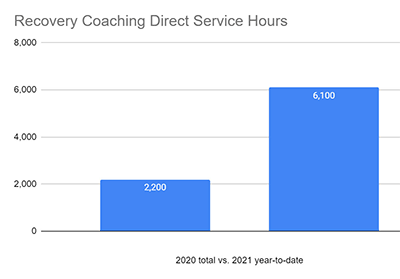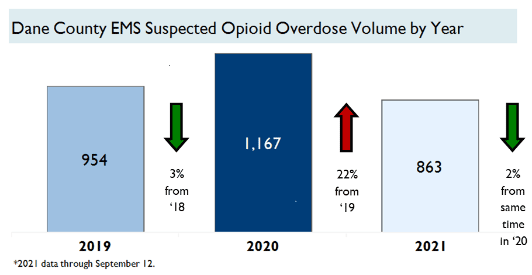
 Unfortunately, mental health emergencies can escalate into incidents that precipitate a law enforcement response. In areas where this involves domestic violence or drug/alcohol abuse, this can create very volatile, tenuous situations. While our deputies are trained and certified at crisis response, it’s important we match the right community resource with the challenge at hand. For calls in which mental and behavioral health are at the root of what’s occurring, we’ve partnered with Journey Mental Health on an almost $400,000 Crisis Response service. These mental health workers are available to respond to scenes to help de-escalate situations and right now two of these positions are dedicated to responses by the Dane County Sheriff’s Office. We know the increasing prevalence of this call type and that we can do more.
Unfortunately, mental health emergencies can escalate into incidents that precipitate a law enforcement response. In areas where this involves domestic violence or drug/alcohol abuse, this can create very volatile, tenuous situations. While our deputies are trained and certified at crisis response, it’s important we match the right community resource with the challenge at hand. For calls in which mental and behavioral health are at the root of what’s occurring, we’ve partnered with Journey Mental Health on an almost $400,000 Crisis Response service. These mental health workers are available to respond to scenes to help de-escalate situations and right now two of these positions are dedicated to responses by the Dane County Sheriff’s Office. We know the increasing prevalence of this call type and that we can do more.
Working with Sheriff Barrett and his counterpart in Cook County, Illinois, we’re debuting new mental health response tools, trainings, and processes for Dane County Sheriff’s Deputies in this budget. Mental health and substance abuse are at the root of countless emergency calls and can place our deputies in precarious situations where the focus of their work becomes de-escalation. This is easier said than done for individuals experiencing a mental health crisis or under the influence of drugs or alcohol. Based on a successful model launched last December in Cook County, I’m putting $250,000 in the budget to launch this new virtual mental health program. These dollars cover the cost of clinical staff, tablets, and remote WiFi modems so when our deputies come upon a crisis situation they have the support they need to assist families. The program is quite simple and is based on the lessons learned for telemedicine thru the course of the Covid-19 pandemic. Our deputies will carry tablets to virtually link mental health professionals to those experiencing crisis in real time. On the other side of the screen will be a trained social worker who can address whatever precipitated the law enforcement response. Once situations are stabilized this professional can stay connected to the individual in crisis and help refer them to the county’s Behavioral Health Resource Center for follow-up on treatment. This will connect more in our community in crisis with services that are available as a first resort and hopefully keep more people out of the criminal justice system, instead providing access to the help they need. Of the many new initiatives in this budget I’m most excited about the prospect for this work and how through technology we can better link law enforcement and human services for the betterment of our citizens.
The scourge of addiction continues to pose significant hardship in our community. Deaths from overdoses hit an all-time high in 2020 and numbers through the first 8 months of this year are showing little decline in these tragedies. Through the end of August there were 833 ambulance calls in Dane County this year for suspected opiate overdoses. One in five of those calls were for overdoses among African American individuals, showing the disproportionate impact the opiate epidemic is having among certain communities. There’s been a 23% increase this year over 2019 in the number of times EMS agencies have administered the overdose reversing medication “Narcan” to patients. The saddest data point on the prevalence of overdoses comes from the Dane County Medical Examiner’s Office which reports 149 people died from overdoses in our county last year. That’s two and a half times more than the figure from 2019 (60 deaths due to overdoses). We are not alone. Overdose deaths doubled in Rock County last year and were four times higher in Brown County than the year before.

One of our most impactful efforts at the fight against opiate addiction is the recovery coach program we partner on with the Safe Communities Coalition. An initiative that started in a couple of local hospital emergency rooms is now available countywide, including in our Dane County Jail. All told, we’ve invested over $420,000 in county dollars each year on this meaningful, yet time intensive recovery work that links someone struggling from addiction with an advocate to help them navigate the many pitfalls of the treatment, healing, and recovery process. Breaking the cycle of addiction with opiates is incredibly difficult because of how they change the body’s chemical make-up. That makes it harder for individuals to find healing and peace and impacts the ability to work. For those with severe addictions who don’t culminate in tragedy, their home and work lives can spiral as they cycle in and out of the criminal justice system on numerous occasions. The Safe Communities “Recovery Coach” program saw a 55% increase in its work this year, in part because it was a leading point of referral for individuals who connected with the county’s Behavioral Health Resource Center looking for help. Given that, I’m adding $100,000 in the budget for more recovery coaches, including the work needed in our jail, known as “Jail to Recovery.” This will help reduce recidivism and is another example of a diversion program where doing more could directly impact lingering questions about the size, scope, and cost of a potential consolidated Dane County Jail project.

Safe Communities continues to be an instrumental partner at driving the county’s “Ending Deaths from Despair Task Force.” Despite our strong local economy, active social networks, and excellent health care, Dane County has not been spared ‘deaths from despair.’ Opiate overdoses have increased. The risk of suicide and harm from other substance use disorders, such as alcoholism, remain prevalent. The Task Force I convened started meeting in 2021 and is made up of Dane County health care leaders, youth and senior service agencies, public safety officials, large employers, along with mental health and substance use disorder treatment providers, LGBTQ, African American, and Latino Advocacy organizations. The group is developing a work plan to help prevent the irreparable pain brought on by suicide and other preventable deaths. This plan will launch in earnest in the coming year.
I’m also adding a position to the Sheriff’s Office in this budget to focus on the heinous crimes associated with sex trafficking. A few years ago I added staff in the Department of Human Services’ Neighborhood Intervention Program to help those at risk of falling victim to trafficking. This new detective will be dedicated to investigating these crimes and bringing traffickers to justice. At a total cost of $119,000 annually, it will focus exclusively on preventing vulnerable girls and young women from falling prey to these criminals.
There continue to be far too many needless tragedies in our community resulting from gun violence. Madison had 250 shots fired incidents in 2020 in which 48 people were hit by gunfire. While those numbers year to date are on pace to be down a bit, far too many families are grieving and too many neighborhoods are living on edge. Several months ago Public Health Madison/Dane County convened its Violence Prevention Coalition, a community based group tasked with developing recommendations and a roadmap on ways to ramp up preventative efforts to help prevent situations from escalating into gunfire and other violent crimes. They’ve developed best practices for violence prevention that will help better organize the variety of initiatives underway to reduce the number of times conflicts escalate into tragedy.
This group found a few themes in its work which both the city and county are addressing through their joint funding of the Public Health Department in this budget. First, there are individuals in the community at risk of being involved in violent crimes who aren’t being connected to available services. Similar to most services, there are existing limitations to capacity and the number of people able to be served. There are also pre-existing limitations in some programs. For example, one program that aims to better connect fathers with their children is currently only available to fathers in the prison system which means dads in jail aren’t able to take advantage of this particular help. Another key finding of the group is the lack of a centralized place to collect and organize the data needed to interconnect existing services with those at risk. This will help collate referrals not just from law enforcement, but also social workers – like Dane County’s Neighborhood Intervention Program – and community partners. That work will cast a wider, more cohesive net to identify individuals who may benefit from the help that is available and get them connected with it, ideally before they become part of the criminal justice system. The data systems will be developed and maintained by Public Health staff.
I’m proposing this roadmap to reduce gun violence include $300,000 from the county so efforts to bridge resources extends beyond Madison’s city limits. These dollars will help engage young people ages 14-24 who have been disconnected from school and/or work and help re-root them. It will also establish streamlined referral systems to services, crisis intervention, and help treat survivors who face very real trauma. These dollars will be awarded via contracts to community partners who have the peer mentoring skills to help make a difference. This is the right framework to bring people together, better connect services, and get that help to those at risk.